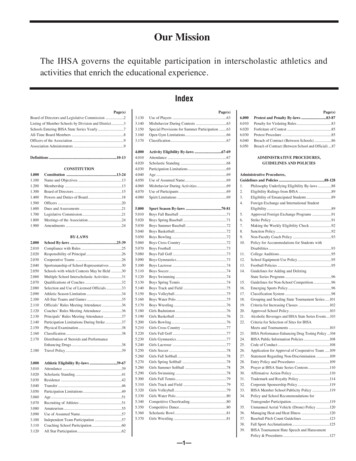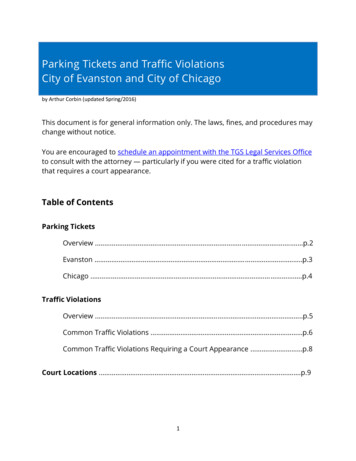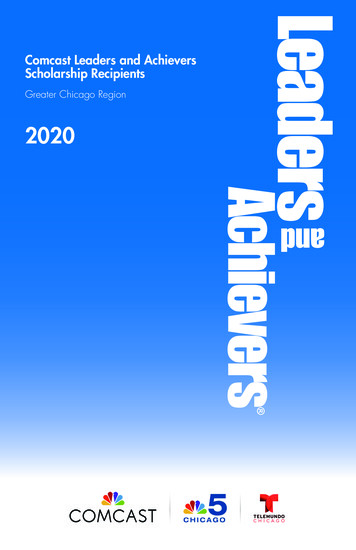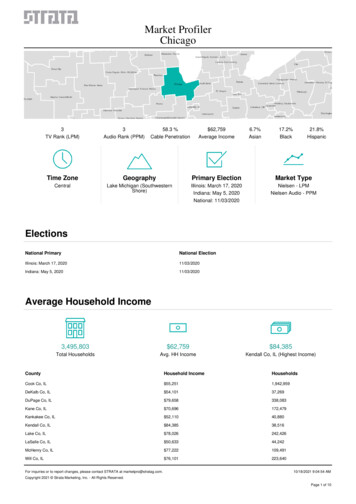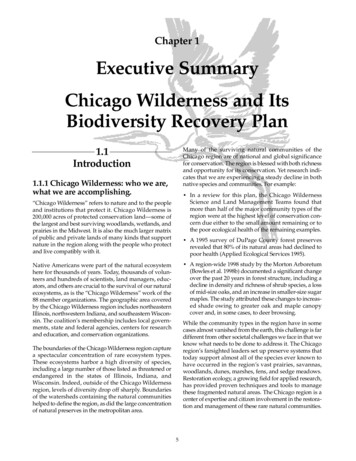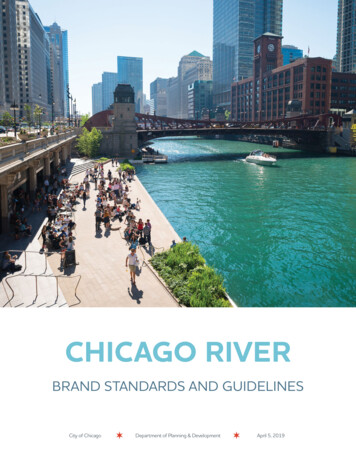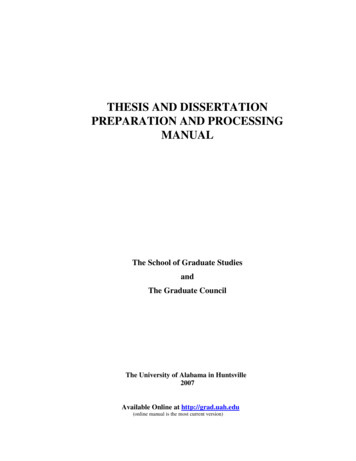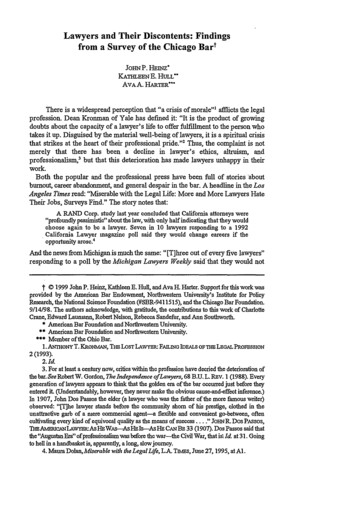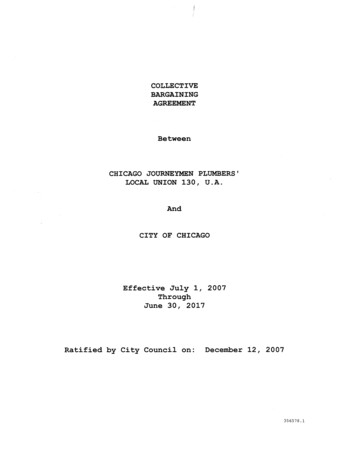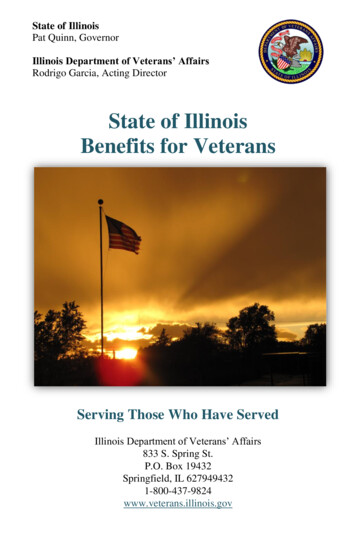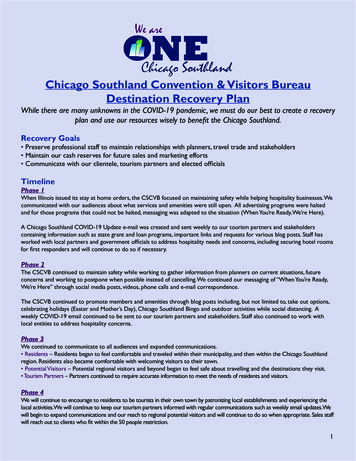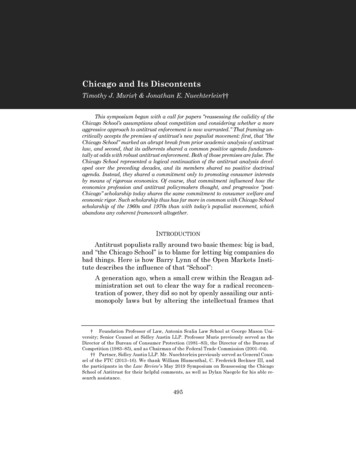
Transcription
Chicago and Its DiscontentsTimothy J. Muris† & Jonathan E. Nuechterlein††This symposium began with a call for papers “reassessing the validity of theChicago School’s assumptions about competition and considering whether a moreaggressive approach to antitrust enforcement is now warranted.” That framing uncritically accepts the premises of antitrust’s new populist movement: first, that “theChicago School” marked an abrupt break from prior academic analysis of antitrustlaw, and second, that its adherents shared a common positive agenda fundamentally at odds with robust antitrust enforcement. Both of those premises are false. TheChicago School represented a logical continuation of the antitrust analysis developed over the preceding decades, and its members shared no positive doctrinalagenda. Instead, they shared a commitment only to promoting consumer interestsby means of rigorous economics. Of course, that commitment influenced how theeconomics profession and antitrust policymakers thought, and progressive “postChicago” scholarship today shares the same commitment to consumer welfare andeconomic rigor. Such scholarship thus has far more in common with Chicago Schoolscholarship of the 1960s and 1970s than with today’s populist movement, whichabandons any coherent framework altogether.INTRODUCTIONAntitrust populists rally around two basic themes: big is bad,and “the Chicago School” is to blame for letting big companies dobad things. Here is how Barry Lynn of the Open Markets Institute describes the influence of that “School”:A generation ago, when a small crew within the Reagan administration set out to clear the way for a radical reconcentration of power, they did so not by openly assailing our antimonopoly laws but by altering the intellectual frames that† Foundation Professor of Law, Antonin Scalia Law School at George Mason University; Senior Counsel at Sidley Austin LLP. Professor Muris previously served as theDirector of the Bureau of Consumer Protection (1981–83), the Director of the Bureau ofCompetition (1983–85), and as Chairman of the Federal Trade Commission (2001–04).†† Partner, Sidley Austin LLP. Mr. Nuechterlein previously served as General Counsel of the FTC (2013–16). We thank William Blumenthal, C. Frederick Beckner III, andthe participants in the Law Review’s May 2019 Symposium on Reassessing the ChicagoSchool of Antitrust for their helpful comments, as well as Dylan Naegele for his able research assistance.495
496The University of Chicago Law Review[87:495guide how we enforce them. . . . [T]he new goal was “efficiency.” Rather than protect the “opportunity” of the citizenproducer, the new goal was to promote the “welfare” of the“consumer.” 1The result? An “overthrow of our antimonopoly laws,” leadingAmerica to become “an economic—hence political—autocracy.”2Taking such rhetoric at face value, this symposium originatedwith a call for papers “reassessing the validity of the ChicagoSchool’s assumptions about competition and consider[ing]whether a more aggressive approach to antitrust enforcement isnow warranted.”3 Yet the very framing of that question is problematic because it uncritically accepts the populist movement’sskewed historical narrative. As Lynn’s quote illustrates, thatmovement assumes, first, that the Chicago School marked an abrupt shift from prior academic approaches to antitrust law, andsecond, that its adherents shared a common positive agenda fundamentally at odds with robust antitrust enforcement. In fact,both of those premises are false, and exposing them as such placestoday’s populism in much-needed perspective.Although the Chicago School of the 1960s and 1970s madecritical contributions to the field, it represented a logical continuation of, not a radical break from, the modes of antitrust analysisdeveloped by thoughtful scholars over the preceding decades. Consider some key principles that populists attribute to the ChicagoSchool and accordingly vilify—that antitrust should address only“harm to competition” rather than mere “harm to competitors”;that “harm to competition” means harm to consumer interests;and that antitrust should thus narrowly circumscribe a largefirm’s liability for charging low prices, even if they drive smaller,less efficient businesses from the market.1Barry C. Lynn, No Free Parking for Monopoly Players: Time to Revive Anti-TrustLaw (The Nation, June 8, 2011), archived at https://perma.cc/6QZ5-EMTB.2Id. See also Mark Glick, The Unsound Theory Behind the Consumer (and Total)Welfare Goal in Antitrust, 63 Antitrust Bull 455, 456–58 (2018); Lina M. Khan, The Ideological Roots of America’s Market Power Problem, 127 Yale L J F 960, 965–70 (2018);Marshall Steinbaum, Eric Harris Bernstein, and John Strum, Powerless: How Lax Antitrust and Concentrated Market Power Rig the Economy Against American Workers, Consumers, and Communities *16–17 (Roosevelt Institute, Feb 2018), archived athttps://perma.cc/38K7-Q4Y9; Marc Jarsulic, et al, Reviving Antitrust: Why Our EconomyNeeds a Progressive Competition Policy *11–13 (Center for American Progress, June 2016),archived at https://perma.cc/7FKN-MUJA.3Call for Papers: Symposium on Re-Assessing the Chicago School of Antitrust Law(U Chi L Rev 2018), archived at https://perma.cc/6Q8D-RCX4.
2020]Chicago and Its Discontents497These hallmarks of the “consumer welfare” standard did notoriginate at Chicago. They all appeared prominently in critiquesof the Robinson-Patman Act4 in the 1950s and 1960s by such nonChicago scholars as Frederick Rowe,5 Professor Morris Adelman,6and Professor Robert Pitofsky.7 The same principles also appeared in two 1949 articles attacking the government’s successfulSherman Act prosecution of the giant A&P supermarket chain fordecimating less efficient corner grocers through low prices andvertical integration. Those articles—one by MIT’s Adelman8 andthe other by then–Yale Law student Donald Turner9—exposedthe economic incoherence of the government’s case and, in particular, its failure to show how harm to A&P’s smaller rivals couldpossibly harm consumers. When Turner simultaneously identified the “potential contradiction” underlying the government’s antitrust philosophy—that is, its tendency to suppress welfareenhancing competition while purporting to promote it10—he foreshadowed Robert Bork’s claim almost thirty years later that antitrust policy had become “a policy at war with itself.”11 And theSupreme Court’s Brooke Group Ltd v Brown & Williamson Tobacco Corp12 predatory pricing standard,13 so widely condemnedby populists today, essentially follows a proposal set forth in a 1975law review article that Turner coauthored with his Harvard colleague Professor Phillip Areeda after returning from a stint as DOJantitrust chief in an economically liberal Johnson Administration.144Pub L No 74-692, 49 Stat 1526 (1936), codified as amended at 15 USC § 13.See Frederick M. Rowe, The Evolution of the Robinson-Patman Act: A Twenty-YearPerspective, 57 Colum L Rev 1059, 1060 (1957); Frederick M. Rowe, Price Discrimination,Competition, and Confusion: Another Look at Robinson-Patman, 60 Yale L J 929, 940–42(1951); Part II.A.6See M.A. Adelman, A&P: A Study in Price-Cost Behavior and Public Policy 160–79 (Harvard 1959).7See Report of the American Bar Association Commission to Study the FederalTrade Commission 67–68 (1969) (Robert Pitofsky, ABA Commission Counsel).8See generally Morris A. Adelman, The A&P Case: A Study in Applied EconomicTheory, 63 Q J Econ 238 (1949).9See generally Note, Trouble Begins in the “New” Sherman Act: The PerplexingStory of the A&P Case, 58 Yale L J 969 (1949). See also Adelman, A&P at 18 & n 9 (citedin note 6) (identifying Turner as the author of the Yale Note).10 Note, 58 Yale L J at 969–71 (cited in note 9).11 Robert H. Bork, The Antitrust Paradox: A Policy at War with Itself 7 (BasicBooks 1978).12 509 US 209 (1993).13 Id at 222–23.14 See Phillip Areeda and Donald F. Turner, Predatory Pricing and Related PracticesUnder Section 2 of the Sherman Act, 88 Harv L Rev 697, 715 (1975). See also notes 95–99and accompanying text.5
498The University of Chicago Law Review[87:495Progressive “post-Chicago” scholarship today also has farmore in common with Chicago School scholarship of the 1960sand 1970s than with today’s populist movement. To appreciatethis point, we must distinguish between two different types of antitrust criticism: (1) economically rigorous efforts to identify newcontexts in which aggressive antitrust intervention is needed topromote consumer welfare and (2) populist movements to dispense with consumer welfare as the sole or even primary focus ofantitrust concern. Initiatives in the first category include “raisingrivals’ costs” theories of harm, developed by Professors StevenSalop, Thomas Krattenmaker, and others starting in the 1980s.15Such theories rest on rigorous economic foundations and retainan appropriately sharp focus on consumer welfare. These proposals for increased antitrust intervention accordingly involve anevolution of thinking associated with the Chicago School, not aconceptual break from that thinking,16 just as Chicago itself represented an evolution of pre–Chicago School antitrust analysis.In contrast, populist initiatives in the second category—that is, todispense with consumer welfare as the primary focus of antitrust—have no clear conceptual objectives other than reining inlarge global companies that displace smaller, more local, and lessefficient companies. This movement does indeed reject the ChicagoSchool, but only in the same sense that it broadly rejects a moregeneral commitment to consumer interests.These are important points for antitrust authorities, scholars, and practitioners to understand today. They should help defuse political rhetoric about the Chicago School label and identifythe true ideological fault line today’s debates: between those whodo and those who do not view consumer interests as paramountin antitrust doctrine.I. “CHICAGO SCHOOL”: AN EPITHET IN NEED OF HISTORICALCONTEXTThe term “Chicago School” is typically associated with antitrust literature written by scholars who either taught at or had15 See Thomas G. Krattenmaker and Steven C. Salop, Anticompetitive Exclusion:Raising Rivals’ Costs to Achieve Power over Price, 96 Yale L J 209, 253–55 (1986); note 124and accompanying text (discussing the Chicago School antecedents of these theories).16 Andrew I. Gavil, William E. Kovacic, and Jonathan B. Baker, Antitrust Law inPerspective: Cases, Concepts, and Problems in Competition Policy 70 (Thomson/West 2d ed2008) (“Post-Chicago commentators generally propose qualifying rather than supplantingChicago views.”).
2020]Chicago and Its Discontents499attended the University of Chicago from the mid-1950s throughthe 1970s. These included Professors Aaron Director and EdwardLevi, who taught an enormously influential antitrust course therebeginning in the 1950s, and Richard Posner and Frank Easterbrook,who began supplementing their teaching duties in the 1980s withservice on the Seventh Circuit, where they influenced antitrustlaw more directly.17 Ironically, the figure most commonly associated today with the Chicago School, Robert Bork, never taughtthere. But as a 1953 graduate of the Law School, he creditedDirector and Levi, among others, for shaping the early development of his antitrust philosophy.18The Chicago School has had an undeniably important influence on how courts, practitioners, and scholars have viewed antitrust law for the past half century. But popular accounts havetended to misunderstand the nature of that influence. To dispelthe confusion, we must distinguish among three types of questions:(1) What are the ultimate objectives of antitrust—thepromotion of consumer interests or some othergoal/goals?(2) What is the correct mode of analysis for measuringantitrust’s success in meeting those designatedobjectives—economic/empirical analysis or somethingelse?17 Richard A. Posner, Antitrust: Cases, Economic Notes and Other Materials xiii(West 1st ed 1974). In 1974, Posner described his new antitrust casebook asa successor to mimeographed materials first prepared by Edward H. Levi andused by him and Aaron Director in the course on antitrust law that they taughtjointly at the University of Chicago Law School for many years. On the last classof each week of the course, Professor Director would present an economist’s comments on the cases discussed during the week. The economics notes scatteredthroughout this casebook attempt to do what Professor Director’s lectures did:expound the relevant economic concepts against the background of particularcases that illustrate the relevance of the concepts to the issues of antitrust law. . . Much of the economic analysis expounded in these notes is based on ideasfirst proposed by Director. A number of these ideas were later developed andpublished by other economists whose work I do cite. These citations concealDirector’s seminal role in the development of the economics of competition andmonopoly presented in this book.18See Bork, Antitrust Paradox at ix–x (cited in note 11).
500The University of Chicago Law Review[87:495(3) What substantive antitrust rules would best ensure thatantitrust serves its designated objectives?When populist critics attack the Chicago School, they areoften (though not invariably) attacking what they perceive asChicago’s answer to the third question, concerning antitrust doctrine. Populists routinely assume that Chicago School focused on,and favored “conservative” approaches to, the doctrinal content ofantitrust law. There is of course a kernel of truth in that assumption. Some individual Chicago School scholars did indeed advocate broad limits on market intervention. In addition to Bork,these included Frank Easterbrook, who advocated a “profoundlyskeptical program” that would limit antitrust enforcement to “little other than prosecuting plain vanilla cartels and mergers tomonopoly.”19It is also true that scholars associated with the ChicagoSchool challenged long-held but poorly tested assumptions supporting antitrust intervention in particular contexts. By the early1970s, much of antitrust policy reflected the “simple market concentration doctrine,” which held that even modest degrees of market concentration were inherently harmful, even in seeminglywell-functioning markets.20 Economists, enforcement agencies,and many in Congress had all invoked that doctrine to supportseveral aggressive forms of antitrust intervention, such as suitsto block mergers even in reasonably unconcentrated markets andemerging initiatives to hold companies liable under novel § 2 theories of “no-fault monopoly” and “shared monopoly.”21 The research of Professor Harold Demsetz and others associated withthe Chicago School, commemorated in a 1974 volume of essays,helped defuse this movement by refuting the empirical premisesof the simple market concentration doctrine.22 This ChicagoSchool–led scholarship ultimately led industrial organizationeconomists and antitrust authorities to take a more nuanced view19Frank Easterbrook, Workable Antitrust Policy, 84 Mich L Rev 1696, 1701 (1986).See Bruce H. Kobayashi and Timothy J. Muris, Chicago, Post-Chicago, and Beyond: Time to Let Go of the 20th Century, 78 Antitrust L J 147, 167 (2012).21 See generally Timothy J. Muris, Economics and Antitrust, 5 Geo Mason L Rev303 (1997).22 See Harold Demsetz, Two Systems of Belief About Monopoly, in Harvey J. Goldschmid,H. Michael Mann, and J. Fred Weston, eds, Industrial Concentration: The New Learning164, 170–74 (Little, Brown 1974).20
2020]Chicago and Its Discontents501of market concentration in the modern economy, with critical implications both for merger-enforcement policy and for the novel§ 2 theories of the 1970s.23That said, populists are wrong to equate the Chicago Schoolin general with advocacy for conservative antitrust doctrine. Asone of us has written, the scholars associated with that Schoolhad no single affirmative program for antitrust; they were unifiedonly in their rejection of the intellectual incoherence that hadcharacterized so many mid-century antitrust decisions.24 For example, while Frank Easterbrook proposed a rule of per se legalityfor all price cuts by monopolists,25 Richard Posner not only rejected that position, but also criticized, as too permissive and prodefendant, the mainstream predatory pricing test advocated byHarvard Professors Areeda and Turner.26 And Chicago Schoolscholars were all over the map on merger policy. Bork’s thenpermissive views came close to those of the Obama Justice Department decades later, whose 2010 guidelines effectively madefour-to-three mergers the marginal case.27 Posner advocated apolicy far more restrictive than the Obama DOJ’s; his approachwould presumptively bar any merger leaving a four-firm concentration level greater than 60 percent.28 And the Chicago School23 The essays collected in Industrial Concentration: The New Learning summarizeddiscussions at a seminal March 1974 conference at Virginia’s Airlie House on the concentration issue. See Harvey J. Goldschmid, H. Michael Mann, and J. Fred Weston, eds, Industrial Concentration: The New Learning vii–viii (Little, Brown 1974). The conferencewas formatted as a debate between proponents of the simple concentration school, thenconstituting the vast majority, and its opponents, almost all associated with the ChicagoSchool. The effect on policy and doctrine was profound, especially in tempering hostility tomergers, but also in undercutting the expansion of “no fault” and “shared monopoly” theories of Section 2 liability. The Chicago position succeeded not because it favored entrenched interests or big business, but because it rested on the types of sound economicanalysis that those on both sides of the debate favored. See Jonathan B. Baker, Book Review, Economics and Antitrust Policy, 34 Antitrust Bull 919, 920 (1989). See also note 117(addressing today’s market-concentration controversies).24 Kobayashi and Muris, 78 Antitrust L J at 167–68 (cited in note 20).25 Frank H. Easterbrook, Predatory Strategies and Counterstrategies, 48 U Chi L Rev263, 333–37 (1981).26 See Richard A. Posner, Antitrust Law: An Economic Perspective 191–93 (Chicago1976) (criticizing Areeda and Turner).27 Compare Bork, Antitrust Paradox, at 221–22 (cited in note 11) (advocating for aninterpretation that would make four-to-three mergers presumptively lawful but not threeto-two mergers), with Federal Trade Commission, Federal Trade Commission Workshopon Horizontal Merger Guidelines Review Project *23–24 (Jan 26, 2010), archived athttps://perma.cc/WS2T-MJ5F (“The assumption there was sort of a six to five [merger] wasthe threshold where we would start getting concerned, it looks more like where we aretoday is five to four or four to three.”).28 See Posner, Antitrust Law at 112 (cited in note 26).
502The University of Chicago Law Review[87:495scholar with the greatest actual influence on merger policy—Reagan DOJ antitrust chief William Baxter—endorsed an approach that is highly restrictive by today’s standards. His approach is reflected in the 1982 merger guidelines, which made sixto-five mergers the marginal case.29In short, the animating spirit that unified the Chicago Schoolrelated less to the third question above—How interventionistshould antitrust doctrine be?—than to the first two: What is antitrust’s objective, and how should we measure success in meetingit? The Chicago School’s answers to these questions are wellknown. Chicago School scholars identified the interests of consumers as the paramount concern of antitrust and opposed “balancing” them against other, typically conflicting interests, suchas the desire of small businesses to avoid price competition fromlarger, more efficient businesses.30 And Chicago School scholarsalso chose rigorous economics as the preferred means of determining whether antitrust doctrine was actually serving consumerwelfare.31 As we next discuss, however, Chicago School scholarsdid not invent these approaches to antitrust. Instead, their insights built on the earlier insights of others, stretching back tothe first half of the twentieth century, and coexisted with similarinsights by non-Chicago contemporaries.II. CHICAGO’S PRIOR ARTIf the Chicago School had sought to patent its use of the consumer welfare standard and rigorous economic analysis, it wouldhave confronted two formidable objections. The first, discussedimmediately below, would have been the “prior art”: scholars unassociated with the Chicago School had long advocated both theprimacy of consumer interests and economic analysis. And thesecond objection, discussed in Part III below, would have been aproblem of “obviousness.” These non-Chicago scholars favored thesame approach as the Chicago School not by coincidence, but because mid-century antitrust precedents had made it obvious that29 See United States Department of Justice Antitrust Division, Merger Guidelines,47 Fed Reg 28493, 28497 (1982) (“Markets . . . having the equivalent of no more than approximately six equally sized firms [are considered to be highly concentrated]. Additionalconcentration resulting from mergers is a matter of significant competitive concern.”).30 See Bork, Antitrust Paradox at 89 (cited in note 11) (“[T]he case is overwhelmingfor judicial adherence to the single goal of consumer welfare in the interpretation of theantitrust laws.”).31 See Kobayashi and Muris, 78 Antitrust L J at 152 (cited in note 24) (discussingthe Chicago School’s use of theoretical and empirical economics to analyze antitrust law).
2020]Chicago and Its Discontents503antitrust would remain an incoherent muddle until it refocusedon consumer welfare and economics.A. Robinson-Patman Criticism: Adelman, Rowe, and PitofskyMuch of the pre–Chicago School scholarship32 foreshadowingthe modern consumer welfare standard appeared in response tothe most important antitrust legislation of the interwar period:the Robinson-Patman Act of 1936, whose lessons are too often forgotten in antitrust commentary today.33 The Act generally prohibits a supplier from selling “commodities of like grade and quality”at different prices to different buyers, except that (among otherexceptions) the seller may offer special discounts to “meet” competition and may make “due allowance for differences in the costof manufacture, sale, or delivery.”34 A Yale Law professor presciently observed a year after passage that the Act’s prohibitions andarcane exceptions would elevate “arbitrariness and guesswork”over economic theory and that “[t]rial is to proceed by the ordealof cost accountancy.”35More problematically, the Act was not only poorly written,but poorly conceived. Originally entitled the “Wholesale GrocersProtection Act,”36 it was explicitly enacted to protect entrenchedeconomic interests—wholesalers and small retailers—by keepinglarge chain stores such as the supermarket giant A&P from underselling their smaller rivals by acquiring goods at a discount,bypassing middlemen, and passing along the savings to consumers.37 As Chief Judge Diane Wood (a liberal member of theChicago Law faculty) explained for the Seventh Circuit in 2016,32 Our use of the phrase “pre-Chicago” denotes the period before the modern ChicagoSchool’s scholarship became widely known in the 1960s. Of course, the University of Chicagohad important antitrust scholars before Professors Director and Levi, but they are nottypically associated with the modern Chicago School.33 See Timothy J. Muris and Jonathan E. Nuechterlein, Antitrust in the Internet Era:The Legacy of United States v. A&P, 54 Rev Indust Org 651, 666–67 (2019) (arguing thatthe Act was a result of “antitrust [being] divorced from an economically rigorous focus onconsumer welfare” and that modern antitrust critics similarly fail to distinguish “betweenharm to competitors and harm to competition”); Hugh C. Hansen, Robinson-Patman Law:A Review and Analysis, 51 Fordham L Rev 1113, 1187–96 (1983) (discussing the harmfuleffects of the Act, including increased costs of doing business, price rigidity, and pricefixing).34 15 USC § 13(a), (b).35 Walton H. Hamilton, Cost as a Standard for Price, 4 L & Contemp Probs 321, 323,328 (1937).36 Hansen, 51 Fordham L Rev at 1123 (quotation marks omitted) (cited in note 33).37 See Muris and Nuechterlein, 54 Rev Indust Org at 656–58 (cited in note 33).
504The University of Chicago Law Review[87:495the Robinson-Patman Act’s “‘fit with . . . antitrust policy is awkward, as it was principally designed to protect small businesses’at the expense of consumers.”38The preeminent mid-century expert on the Robinson-PatmanAct was Fred Rowe, who published the leading treatise on thesubject.39 In 1951, while still a law student, Rowe criticized theAct in the Yale Law Journal for harming welfare-enhancing competition in the name of promoting individual competitors.40 As henoted, other scholars had rightly characterized the Act as “a partof the struggle between the older and newer organizations in distribution in which the older group sought protection from thestate presumably because it was not prepared to rely on the outcome of competition.”41 Rowe illustrated the point by quoting awholesaler lobbyist who complained to Congress that the federalantitrust agencies had acted with insufficient “zeal and loyalty forthe Robinson-Patman Act” and had “seem[ed] to have gone off thereservation to follow the will-o’-the wisp of something termed‘hard competition.’” 42 Rowe observed that when the agencies applied the Act by its terms, as such rent-seekers demanded,“[n]eeded development of lower-cost distribution is impaired.Competitive public policy should not preserve wholesalersagainst the inroads of competition.”43Ultimately, Rowe concluded, the Robinson-Patman Act itselfwas “antithetical to [sound] antitrust policy.”44 He explained: “Tocope with price discrimination as part of a coherent antitrustprogram, law and economics must jibe. Robinson-Patman’sdemonstrated blindness to economic consequences blocks themarket analysis essential to this result.”45 Rowe also expressedconcern that the Act had corrupted antitrust analysis in generaland quoted others with the same view: “The philosophy of the38 Id at 658, quoting Woodman’s Food Market, Inc v Clorox Co, 833 F3d 743, 746 (7thCir 2016), cert denied, 137 S Ct 1213 (2017).39 See generally Frederick M. Rowe, Price Discrimination Under the RobinsonPatman Act (Little, Brown 1962).40 See Rowe, 60 Yale L J at 942–55 (cited in note 5).41 Id at 949 n 136, quoting Arthur R. Burns, The Effectiveness of the Federal AntitrustLaws: A Symposium, 39 Am Econ Rev 689, 695 (1949).42 Rowe, 60 Yale L J at 949 n 136 (cited in note 5), quoting Functional Operation ofthe Federal Trade Commission, Hearings Before Select Committee on Small Business, 81stCong, 2d Sess 65–66 (1950) (statement of R.H. Rowe, United States Wholesale Grocers’Association).43 Rowe, 60 Yale L J at 948–49 (cited in note 5) (footnote omitted).44 Id at 974.45 Id at 974–75 (emphasis added).
2020]Chicago and Its Discontents505Sherman Act appears to be yielding to a policy of ‘ethical competition,’ which does not differentiate between the stability of theindividual firm and the stability of the total economy.”46 Quotinga presidential economic advisor, he worried that this new populisttendency, “by depriving competition of its vigor, [would] deny thepeople those benefits of larger production, lower costs and prices,and improved standard of living which the Sherman Act was designed to promote.”47 All of these observations expressed the essence of the Chicago School’s emphasis on consumer welfare andeconomic rigor—yet they came from a Yale law student in 1951,who was quoting economists in the Truman Administration.Another prominent critic of Robinson-Patman was RobertPitofsky, who, as an NYU professor, was the staff author of awidely publicized 1969 ABA report criticizing the FTC’s institutional deficiencies.48 Pitofsky, too, condemned the FTC’s RobinsonPatman enforcement policies for protecting small companiesagainst larger, more efficient firms and for “equat[ing] injury to aparticular competitor with injury to the competitive process.”49That approach, he observed, “has been detrimental to the consumer in its tendency to suppress price competition, deter experimentation with new and more efficient methods of distribution,and erect barriers to entry into new markets by highly competitive, geographically diversified firms.”50 And he thus urged theFTC to “focus enforcement . . . on instances in which injury tocompetition is clear, taking into account the consumer interest invigorous price competition.”51These are positions that today’s populists vilify and associatewith the Chicago School. But like Rowe, Pitofsky was no Chicagoan.A future FTC Chairman in the Clinton Administration, he explicitly criticized the answers that various Chicago School figuresgave to specific questions of antitrust doctrine.52 As discussed46 Id at 974 n 290, quoting Council of Economic Advisers, Third Annual Report to thePresident 15 (1948), archived at https://perma.cc/LFB8-CX93.47 Rowe, 60 Yale L J at 974 n 290 (cited in note 5), quoting Hearings Before the Subcommittee on a Study of Monopoly Power of the Committee on the Judiciary, House of Representatives, 81st Cong, 1st Sess 114 (1949) (statement of John D. Clark, Council of Economic Advisers) (emphasis added). Rowe returned to these themes six years later in ahighly influential critique of the Act. See Rowe, 57 Colum L Rev at 1060 (cited in note 5).48 See generally Report of the ABA Commission (cited in note 7).49 Id at 67.50 Id (emphasis added).51 Id at 68 (emphasis added).52 See note 121 and accompanying text.
506The University of Chicago Law Review[87:495below, however, he and his fellow “post-Chicago” scholars still focused on an economic analyses o
† Foundation Professor of Law,Antonin Scalia Law School at George Mason Uni-versity; Senior Counsel at Sidley Austin LLP. Professor Muris previously served as the Director of the Bureau of Consumer Protection (1981-83), the Director of the Bureau of Competition (1983-85), and as Chairman of the Federal Trade Commission (2001-04).
